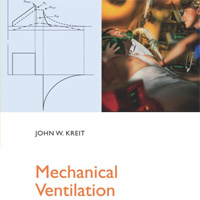Tag: ventilation
Myorelaxants in ARDS patients
Neuromuscular blocking agents (NMBAs) inhibit patient-initiated active breath and the risk of high tidal volumes and consequent high transpulmonary pressure swings, and minimize patient/ ventilator asynchrony in acute respiratory... read more
Airway closure, more harmful than atelectasis in intensive care?
Since the mid-1980s, atelectasis has been demonstrated during anesthesia in lung healthy subjects and in intensive care patients suffering from acute respiratory failure and requiring ventilator support. In the latter... read more
Increased Dead Space Ventilation and Refractory Hypercapnia in Patients with COVID-19
We speculate that thromboinflammation with pulmonary microvasculature occlusion leads to a sudden increase in dead space and shunt resulting in severe hypercapnia and hypoxemia in coronavirus disease 2019 patients. Early... read more
Outcomes of Patients Requiring Prolonged Acute vs. Short-Term Mechanical Ventilation
Over one-third of all hospitalized patients on mechanical ventilation require it for greater than or equal to 4 days. Prolonged acute mechanical ventilation patients exhibit a higher burden of both chronic and acute illness... read more
Efficacy and Safety of a Paired Sedation and Ventilator Weaning
The purpose of this study is to determine the impact of a new RN/RRT (Registered Nurse/Registered Respiratory Therapist) directed 2-step protocol to wean patients off of a ventilator. This protocol involves daily attempts... read more
Early Arterial Embolization and Mortality in Mechanically Ventilated Patients With Hemoptysis
The objective of this study was to clarify whether early intervention by arterial embolization reduced mortality in mechanically ventilated patients with hemoptysis. The results show that early intervention by arterial... read more
ECMO During the Coronavirus Disease 2019 Pandemic
In the midst of the 2009 influenza A H1N1 pandemic, clinicians turned to extracorporeal membrane oxygenation (ECMO) as a strategy to save lives. Based on the H1N1 experience, and the ECMO to Rescue Lung Injury in Severe... read more
Use and Outcomes of Nasotracheal Intubation Among Patients Requiring Mechanical Ventilation Across U.S. PICUs
Nasotracheal intubation is used in a minority of U.S. PICUs and mainly among young cardiac patients. Nasotracheal intubation is associated with a lower rate of unplanned extubations in this patient population. Future... read more
Steroids Confirmed to Help Severely Ill COVID-19 Patients
In patients hospitalized with COVID-19, the use of dexamethasone resulted in lower 28-day mortality among those who were receiving either invasive mechanical ventilation or oxygen alone at randomization but not among those... read more
Mechanical Ventilation: Physiology and Practice
Mechanical ventilation is an essential life-sustaining therapy for many critically-ill patients. As technology has evolved, clinicians have been presented with an increasing number of ventilator options as well as an ever-expanding... read more

Fit-testing of N95/P2-masks to Protect Healthcare Workers
In the context of COVID-19, well fitted respirators e.g. N95/P2-masks are recommended as part of personal protective equipment when performing aerosol generating procedures. Fit-checking is recommended prior to donning... read more
Automated vs. Conventional Ventilation in the ICU
Automated ventilation (AV) appears to reduce the incidence and severity of blood oxygen desaturation during daily nursing procedures (DNPs) in comparison to Conventional Ventilation (CV). Of the 265 included patients,... read more
Is it Safe to Look Yet?
As we start to move to the next stage of the COVID-19 pandemic, it feels like a moment to take stock. The country has gone through huge changes to our way of life over the last few months, and those changes have been mirrored... read more
Respiratory Strategies for Patients with Suspected or Proven COVID-19 Respiratory Failure
The trial objective is to determine if Continuous Positive Airway Pressure (CPAP) or High-Flow Nasal Oxygen (HFNO) is clinically effective compared to standard oxygen therapy in patients with confirmed or suspected COVID-19. The... read more
Development of Persistent Respiratory Morbidity in Previously Healthy Children After ARF
Persistent respiratory morbidity develops in up to potentially 44% of previously healthy children less than or equal to 24 months old at follow-up after acute respiratory failure (ARF) requiring mechanical ventilation. This... read more
Presence of Genetic Variants Among Young Men With Severe COVID-19
In this case series of 4 young male patients with severe COVID-19, rare putative loss-of-function variants of X-chromosomal TLR7 were identified that were associated with impaired type I and II IFN responses. These preliminary... read more
COVID-19: A Hypothesis Regarding the Ventilation-Perfusion Mismatch
We believe that a severe V/Q mismatch underlies the pathophysiology of moderate to severe COVID-19 cases, in which downregulation of ACE2 secondary to viral endocytosis plays a key role. There is low V/Q ratio in areas of... read more
Difficult Bag-Mask Ventilation in Critically Ill Children Is Independently Associated With Adverse Events
Difficult bag-mask ventilation is reported in approximately one in 10 PICU patients undergoing tracheal intubation. Given its association with adverse procedure–related events and oxygen desaturation, future study is warranted... read more
COVID-19 and AKI
Recent reports from China, Italy, and the US indicate that there is a 25-37% incidence of AKI among critically ill COVID-19 patients (Singh 2020, Hirsch et al. 2020). In a study of 5,449 hospitalized COVID-19 patients, acute... read more
Exhaled Air Dispersion During Bag-mask Ventilation and Sputum Suctioning
Mask ventilation and coughing during oro-tracheal suctioning produce aerosols that enhance nosocomial transmission of respiratory infections. We examined the extent of exhaled air dispersion from a human-patient-simulator... read more
COVID-19 – Effective Triage During a Pandemic
The UK is likely on the brink of a major COVID-19 outbreak. About 6% to 10% of infected people are likely to be critically ill, most of whom will require ventilation support in an intensive care environment. Italy is already... read more
Ethnicity and Outcomes in Patients Hospitalised with COVID-19
Preliminary studies suggest that people from Black, Asian and Minority Ethnic (BAME) backgrounds experience higher mortality from COVID-19 but the underlying reasons remain unclear. Prospective analysis of registry data... read more









